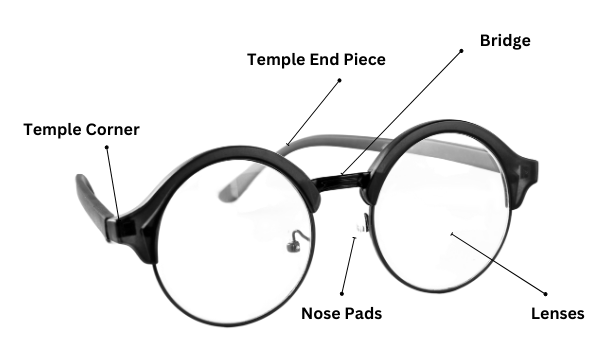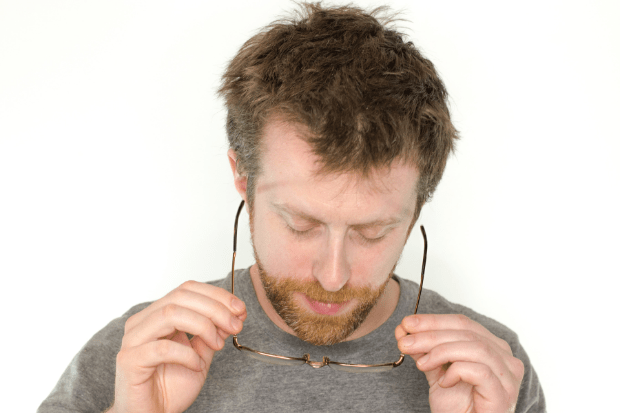How to Adjust Glasses to Fit

To have your prescription glasses fit well and feel good, the fit of your glasses may need to be adjusted. If they slip down your nose or put pressure behind your ears, you may need to make slight adjustments in the frame. Keep in mind, just like shoes, glasses do stretch over time, so you may want to be careful to avoid adjusting the frame too much. Small adjustments to the temples, bridge, and nose pads can raise or lower and tighten or loosen the fit of the frame, improving both fit and your vision.
Why proper fitting glasses are so important
Proper fitting glasses are important for your comfort when wearing the frame and to have the best vision through the lenses. All lens measurements are done according to the fit of the frame. If your eyes are not located in the spot of the lenses where the measurements were performed, you will likely experience blurry vision and distortion, particularly with no-line bifocals and progressives. If your frame does not fit properly, you may experience indentations around your nose or headaches behind your ears.
The anatomy of the prescription glasses

Prescription glasses are composed of 5 key parts.
- Lenses
- Temple Corner
- Temple End Piece
- Bridge
- Nose Pads
You see the world through your prescription lenses. The lenses are customized just for you. If you have no-line bifocals, you must correctly utilize the different viewing distances inside the lens to see at each distance- far, near, and intermediate.
The temples are the profession’s name for the frame “arms.” The corner of the temple is where you will find the hinge that connects the temple to the front of the frame. Hinges often have screws that may loosen with wear over time.
The temple end piece wraps over your ears and helps keep the frame balanced on your face and from slipping down your nose. The frame will slip if the end piece is not tight behind your ear, but you may get headaches if the end piece is bent too tightly.
The bridge of the frame sits on your nose. If the frame is made of acetate, the frame will sit where the bridge touches your nose. If the bridge of your nose is flat, you must consider the bridge fit when you first select a frame, and nose pads may be best.
Nose pads are typically attached to the frame bridge if the frame is made from metal. Though rare, some acetates might be available with nose pads. The nose pads allow for more adjustment to the fit of the bridge and are needed if your nose bridge is low or flat.
How to adjust your glasses at home
Adjusting your glasses at home depends upon the material of your frame. If you have a metal frame, you may be able to slightly bend some parts of the frame, but if you have an acetate frame, the frame must be warmed. After heating a bowl of water for 30 to 60 seconds, the frame can be placed in the bowl to warm the acetate material. Make sure the water is warm and not hot as hot water may damage your lenses and frame. Adjustments to your glasses should be made carefully to avoid snapping your frame or warping the lenses.
Case 1: Glasses are sitting too low on your nose
Glasses that sit too low on your nose are simple to adjust if the frame has nose pads. Use your thumbs to push the nose pads closer together so they are tighter on the edges of your nose. If your frames are made of acetate, raising the glasses can be slightly more difficult. After heating the frame, use your thumbs to push the end of both temples inward and downward. The frame will be tight behind your ears and sit slightly higher on the bridge of your nose.
Case 2: Glasses are pinching your nose
If your glasses are pinching your nose, and your frame has nose pads, use your thumbs to slowly spread the nose pads apart until they feel comfortable on the edges of your nose. After heating your acetate frame, apply outward and upward pressure to the end of the temple so that it becomes looser behind your ears.
Case 3: One lens is higher than the other
If you receive your glasses and one lens is higher, the temple must be bent down on the opposite side of the higher lens. For example, if your right lens is higher, the left temple arm should be bent at either the hinge or at the bend of the ear.
Case 4: One lens is closer to your eye than the other
If one lens appears closer to your eye than the other, the frame adjustment should be made at the hinge. If your left lens seems closer to your eye, it can be corrected by bending the left temple in or the right temple out at the hinge.
Adjusting your glasses parts

Adjusting the different parts of your glasses can improve the fit and comfort of the frames on your face.
How to adjust the tightness of temples
The tightness of your glasses can be adjusted by changing the temples. Slight changes can keep your glasses from sliding down or causing discomfort behind your ear. Metal frame temples can be bent inward or outward to adjust the tightness. The temples on acetate frames can be heated in warm water and manipulated using your fingers. Slowly and carefully, behind the end of the temple, down on both sides so they appear equal. After cooling, try your glasses on to feel the improvements. Your frames can be reheated and bent again until the desired fit is achieved.
How to adjust the height of your frames
The height of the frame can be adjusted using the nose pads on a metal frame or by changing the temples on an acetate frame. If you move the nose pads closer, the frame will sit higher on your nose, and by separating them further, you can lower the frame height. If you purchased an acetate frame, heat the frame and bend the temples at the ear down and inward to increase the height or up and outward to decrease the height.
How to adjust crooked glasses
When your glasses are crooked, it's likely because one side is higher than the other. Place your glasses on the table and observe what opticians call the four point touch. Both temples should be touching the table equally. If one temple is not touching, that temple should be heated and, using slight pressure, be bent to match the other temple. If the left temple is higher than the right, bend the right temple down.
When to visit an optician for glasses adjustment
If you have tried these ideas to adjust your glasses and your glasses still do not fit, a trained optician may be able to help you. Sometimes glasses are just like shoes, you buy a pair because you like the look, but it may not be comfortable after hours of wear. Use our Glasses measurements guides at Overnight Glasses to aid you in selecting the right frame shape and size for your face. Consider the weight of the frame, your eyeglass prescription, and your face structure when ordering a frame.
Conclusion
Because our faces are all different, your eyeglass frame may need an adjustment when it arrives. Adjustments to the bridge and temples of the frame can improve both the comfort and vision of your eyeglasses. Your eyeglasses frames can be made tighter, looser, higher, or lower all by small adjustments to the temples at the hinge or around the ear.
